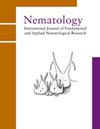不同水稻品种贝氏蚜的动态
IF 1.2
4区 生物学
Q2 ZOOLOGY
引用次数: 0
摘要
贝氏线虫是最具破坏性的植物寄生线虫之一,在中国主要对粳稻造成严重损失。近年来在籼稻种子中发现了线虫病,杂交水稻品种也出现了线虫病危害的症状。为了解不同水稻品种对白僵菌病的防治差异,采用田间试验方法,于2017-2018年在不同水稻品种的种子和幼苗上接种白僵菌,研究了白僵菌的种群动态、发病症状及对植株产量的影响。结果表明,所有品种在苗期和分蘖末均能从植株上恢复少量线虫。开花后,每穗线虫数增加,2017年和2018年以‘浙油18’最多,分别为1050.2和732.1。2017年和2018年接种植株分蘖期出现白尖症状的平均发生率分别为0.5 ~ 10.3%和0.0 ~ 75.7%。籼稻品种‘9311’、‘明恢63’和‘内5优39’在2017年开花期和2018年分蘖期末的白尖症状发生率均显著低于粳稻品种‘兴香’和杂交稻品种‘浙优18’。处理和品种对千粒重和穗长有较强的互作效应。本文章由计算机程序翻译,如有差异,请以英文原文为准。
Dynamics of Aphelenchoides besseyi in different rice cultivars
Aphelenchoides besseyi is among the most devastating plant-parasitic nematodes and causes severe loss, mainly on japonica rice in China. Recently the nematode has been found to be present in the seeds of indica rice and the hybrid rice cultivars also show symptoms of the nematode damage. To understand the variations in different rice cultivars against A. besseyi, the dynamics of nematode population, the incidence of symptoms and the effects on plant yield were investigated in field experiments during 2017-2018 by inoculation of mixed stages of A. besseyi onto the seeds and seedlings of different types of rice cultivars. The results showed few nematodes could be recovered from the plants at the seedling and the end of tillering stages in all the cultivars. After flowering, the number of nematodes per panicle increased and the highest number was found in ‘Zheyou 18’ in 2017 (1050.2) and 2018 (732.1). The average incidence of the inoculated plants showing white-tip symptoms ranged from 0.5 to 10.3% and from 0.0 to 75.7% at the tillering stage in 2017 and 2018, respectively. The incidences of white-tip symptoms in the indica cultivars, including ‘9311’, ‘Minghui 63’ and ‘Nei 5 you 39’, were significantly lower than in ‘Xingxiang’, a japonica cultivar and ‘Zheyou 18’, a hybrid rice cultivar, both at the flowering stage in 2017 and at the end of the tillering stage in 2018. A strong interaction of the treatments and cultivars on the 1000-grain weight and panicle length was evident.
求助全文
通过发布文献求助,成功后即可免费获取论文全文。
去求助
来源期刊

Nematology
生物-动物学
CiteScore
2.60
自引率
33.30%
发文量
67
审稿时长
3 months
期刊介绍:
Nematology is an international journal for the publication of all aspects of nematological research (with the exception of vertebrate parasitology), from molecular biology to field studies. Papers on nematode parasites of arthropods, and on soil free-living nematodes, and on interactions of these and other organisms, are particularly welcome. Research on fresh water and marine nematodes is also considered when the observations are of more general interest.
Nematology publishes full research papers, short communications, Forum articles (which permit an author to express a view on current or fundamental subjects), perspectives on nematology, and reviews of books and other media.
 求助内容:
求助内容: 应助结果提醒方式:
应助结果提醒方式:


